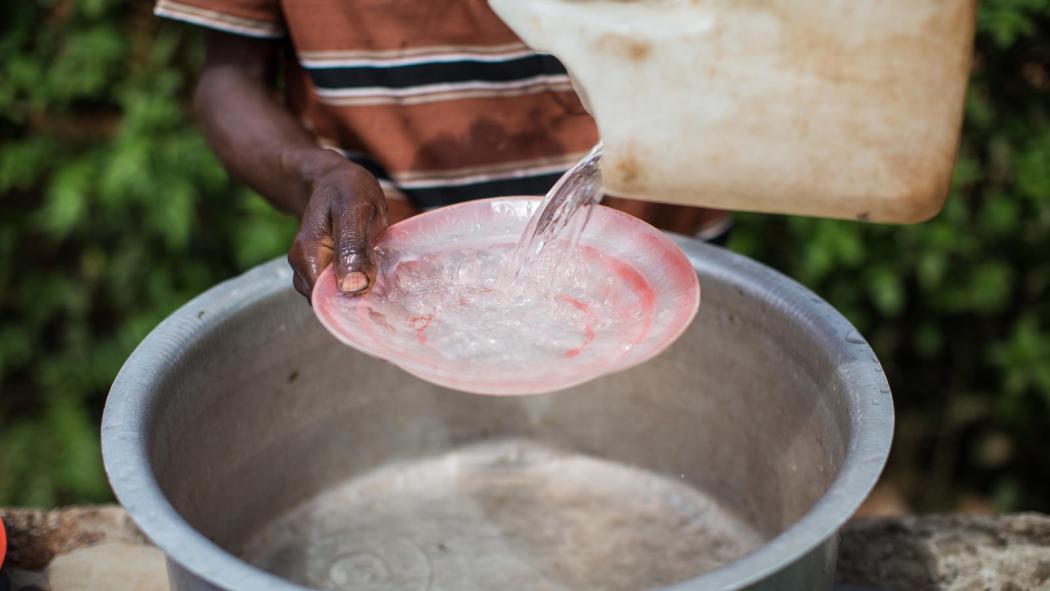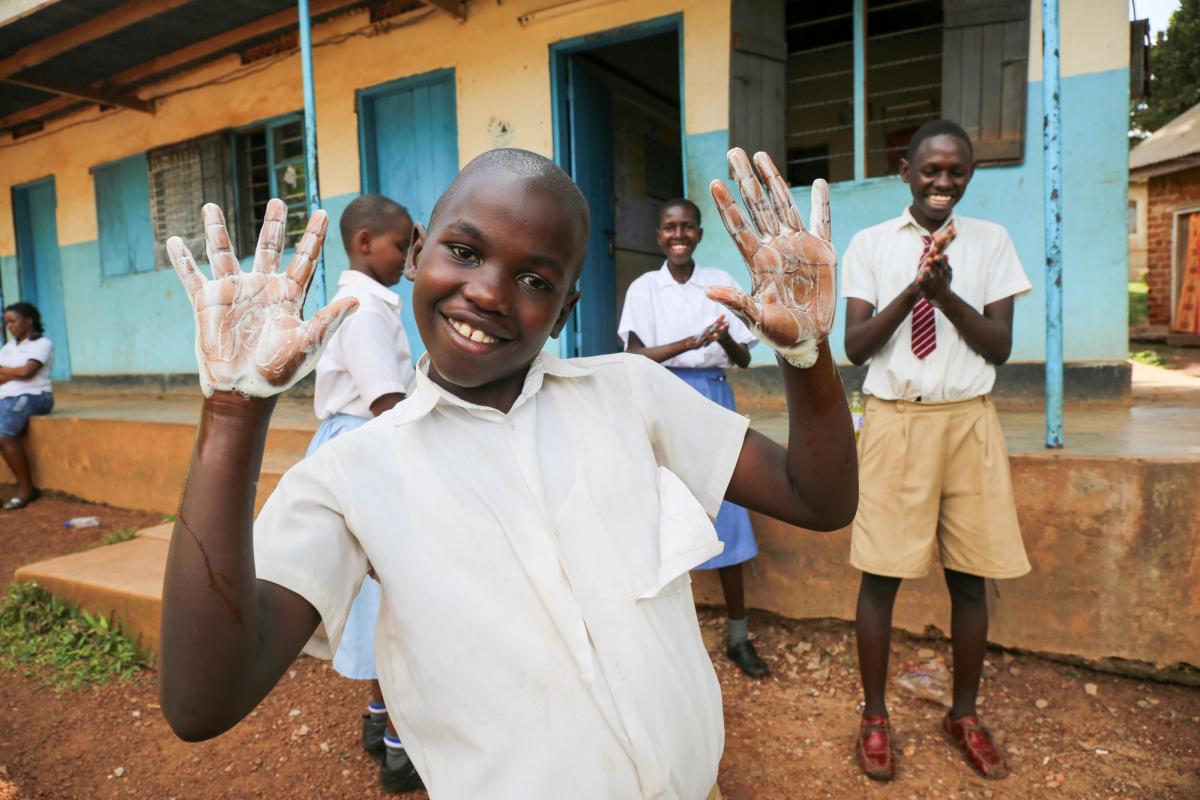Clean hands – a recipe for health: linking hand hygiene and food hygiene

Om Prasad Gautam, Senior WASH Manager for Hygiene, WaterAid UK
Seven in ten cases of diarrhoea in developing countries may be food-borne, with devastating effects on health and development. So why is food hygiene often left out of hygiene promotion? What is the link between food hygiene and hand hygiene? Om Prasad Gautam, WaterAid UK’s Senior WASH Manager for Hygiene, explains the why and how of changing behaviours – and what you can do to help.
Clean hands – recipe for health. Why is food hygiene so important?
Food hygiene could be one of the biggest problems left to solve in development. Handwashing with soap before eating, feeding children or preparing food; thorough cooking and re-heating; clean serving utensils; and proper, lidded storage of cooked food are essential to prevent food-related illnesses and diarrhoeal diseases. Yet a huge proportion of people do not routinely practice good food hygiene and handwashing.
Evidence suggests that unhygienic food preparation and feeding is likely to increase the level of microbiological contamination in food, and thereby the risk of diarrhoeal disease. People with diarrhoea not only eat less but are less able to absorb nutrients from food. For children this seriously impacts physical and cognitive development, and leaves them more vulnerable to future illness.1
This year’s theme for Global Handwashing Day, Clean hands – a recipe for health focuses on the links between handwashing and food, including food hygiene and nutrition. We do have some progress to celebrate – inclusion of handwashing in the SDG 6 agenda; inclusion of handwashing indicators as part of the WHO/UNICEF Joint Monitoring Programme; more data than ever; political attention to handwashing; and fewer children under five dying of diarrhoeal diseases than ten years ago.
But still around half a million children die every year from preventable diarrhoeal diseases.2 Despite the fact that the simple act of washing hands with soap can reduce cases of diarrhoea by up to 48%,3 only 27% of households globally have soap and water for handwashing4 and only 19% of people wash their hands after contact with faeces.5
Studies suggest 70% of diarrhoea in developing countries might be food-borne and from pathogens transmitted through food.6 We need more evidence like this on the role of food hygiene in diarrhoea prevention, to effectively inform and increase the urgency in public health policy and hygiene promotion. And we need clever new ways to improve hygiene, informed by evidence and behaviour-centric approaches – such as those we piloted in Nepal.7
Public health interventions have so far not addressed food contamination enough – it is a huge gap.
The major contributing factors for poor food hygiene include:
- not washing hands before cooking and feeding;
- environmental contamination from poor sanitation;
- using contaminated water to cook and wash utensils;
- using dirty cloths for wiping hands and utensils;
- poor storage practices;
- insufficient cooking time;
- too long between meal preparation and feeding;
- use of unsterilised and dirty feeding bottles.

"From our school health club, I have learnt to wash my hands with water and soap especially after visiting the latrine and before eating food." Mukisa Reagan 12, Member of the School Health Club, Namungona, Rubaga administrative division of Kampala city, Uganda. Photo Credit: WaterAid/ James Kiyimba
What should we do and not do?
Global Handwashing Day offers an important opportunity to greatly increase public awareness of the importance of hand – and food – hygiene. This year, we call for prioritisation, policy change, investment and collective and coordinated efforts towards handwashing programming. Everyone has a part to play – read the end of this blog to find out what you can do.
Interventions to address disease transmission through food have been largely overlooked in both research and programming in low and middle-income settings. Hopefully this year Global Handwashing Day can help to change that.
We need to avoid bad habits in our campaigning too. One-off educational messages telling people to do this and that, wasting money printing caps and t-shirts, or wasting time and resources distributing posters and leaflets only around this day will do little. One push a year won’t be enough to change hand and food hygiene behaviours. And we know that just providing facilities won’t change habits either.
Instead, celebrating the day should be a key entry point to deepen behaviour change work. We need to focus year-round on encouraging people to change their behaviour for good, to maximize the benefits of improved water and sanitation facilities. We need to change habits of a lifetime with evidence-based behavioural change methods8 – emotion/motivation; nudges, cues, and props; making good habits easy and obvious; and encouraging good hygiene as a social norm.
How do we effectively change behaviours – and the situation?
To be effective, hygiene behaviour change interventions must be carefully designed, based on scientific principles of behaviour change, and address multiple key behaviours, including handwashing with soap and food hygiene.
WaterAid has abandoned old-fashioned, patronising and ineffective educational hygiene approaches that repeat messages focusing only on germs and the health benefits of good hygiene. Instead, we have embraced behaviour-centred design approaches, where we listen to communities to understand their universal behavioural determinants – their drivers, motives and ambitions. We then work with creative teams to design innovative and engaging approaches using emotions to bring about lasting positive hygiene behaviour change.
To improve behaviours for good, hand and food hygiene must be better integrated across nutrition, health, education and WASH sectors’ ongoing programming, nationally and internationally. And governments, donors and practitioners must increase finance for complementary food hygiene and handwashing interventions.
We support governments to increase their capacity to execute, prioritise and allocate funding for hygiene behaviour change, water and sanitation interventions. We demonstrate how much more effective innovative and well researched behaviour change campaigns can be than traditional education. And we work with governments to integrate hygiene behaviour change into other sectors, such as health (vaccination, neonatal care), nutrition and education; and to help build (or strengthen) monitoring and evaluation systems to assess behaviours and track the impact of interventions.
I hope this year’s global celebration will encourage stakeholders including governments to prioritise and implement novel, evidence-based programmes at scale. With better finance, integration and prioritisation we can begin to solve this problem.
What can YOU do to improve hand (and food) hygiene?
| Everyone – including children | Wash your hands with soap at critical times especially before eating and feeding. Be a model for handwashing for others. |
| Community leaders / groups | Introduce and encourage handwashing with soap behaviours as social norms and ensure handwashing facilities with soap and water in public places. |
| School | Ensure inclusive handwashing facilities with soap and water in schools, and practise group handwashing. |
| Healthcare centres | Ensure handwashing facilities with soap and water are in different parts of healthcare centres, and that staff demonstrate sustained handwashing practices. Include handwashing as part of health promotion activities. |
| Workplaces | Ensure handwashing facilities with soap and water, and encourage handwashing behaviours for staff at critical times. |
| Policy makers | Ensure a correct policy environment (make hygiene policy, standards and guidelines available at various levels) and allocate more resources for handwashing/hygiene. |
| Government | Ensure responsible/accountable institutions to plan and execute hygiene/handwashing programming, allocating sufficient resources. Integrate hygiene into ongoing programmes. |
| Researchers | Generate data to reduce the evidence gap and share it in a timely manner to inform policy and practice. |
| Programme implementers | Integrate hygiene into ongoing WASH, health, nutrition, education, agricultural and other programmes. Make approaches innovative. |
| Private sector | Private sector has a role, if not responsibility, to promote handwashing. Bring innovative behaviour change products such as handwashing stations and soap closer to where people need them. Integrate handwashing promotion components into ongoing social marketing and promotion activities. |
| Institutional donors and all other types of donors | Prioritise hygiene and ensure sufficient allocation of resources. Invest in innovation and large-scale behaviour change programming. |
See here for the original post on WaterAid's website.
1 Rosenbaum J and Berry R (2017). Essential WASH Actions: A training and reference pack. globalhandwashing.org/resources/essential-wash-actions-a-training-reference-pack-to-supplement-essential-nutrition-actions/
2 www.thelancet.com/infection Published online June 1, 2017 http://dx.doi.org/10.1016/S1473-3099(17)30276-1
3 Ejemot R, Ehiri J, Meremikwu M, Critchley J (2008). Hand washing for preventing diarrhoea. Cochrane Database of Systematic Reviews.
4 WHO/UNICEF (2017). Progress on drinking water, sanitation and hygiene. WHO/UNICEF Joint Monitoring Programme.
5 Freeman M, Stocks M, Cumming O et al (2014). Hygiene and health: systematic review of handwashing practices worldwide and update of health effects. Tropical Medicine and International Health.
6 Ejemot R, Ehiri J, Meremikwu M, Critchley J (2008). Hand washing for preventing diarrhoea. Cochrane Database of Systematic Reviews. 2008
7 WHO (1996). Basic Principles for the preparation of safe food for infants and young children Geneva: World Health Organization.
8 Gautam O, Schmidt W. Cairncross S, Cavill S, Curtis V (2016). Trial of a novel intervention to improve multiple food hygiene behaviours in Nepal. American Journal of Tropical Medicine and Hygiene.
